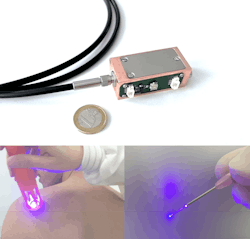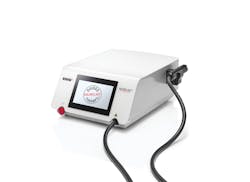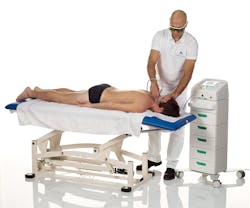Laser therapy for pain relief: current and future trends
Unlike high-power surgical lasers designed for cutting or ablating tissue or destroying tumors, low-level laser therapy (LLLT) is a noninvasive treatment that works by stimulating the body’s natural healing mechanisms in the area where the light is applied. Body tissues then absorb the light and release nitric oxide (NO)—a key signaling molecule that promotes blood flow and increases lymphatic drainage—which in turn inhibits inflammation processes, reduces swelling, and stimulates healing of the surrounding tissues. The light in question is in the red and near-infrared (near-IR) spectrum in 600–950 nm wavelengths, sometimes referred to as cold light because it produces virtually no heat. Low-energy lasers, which induce minimal temperature elevation (0.1 to max. 0.5°C) with powers of 50 to 500 mW and treatment energies of a few joules per square centimeter, can penetrate ~0.5 to 2.0 cm2 and have surface treatment areas of ~0.3 to 5 cm2.
Treatments that require greater penetration depths and larger surface treatment areas often require high-intensity laser therapy (HITL), which uses lasers with higher power levels between 5 and 10 W per wavelength that can penetrate up to 10 cm2 and provide surface treatment areas of 70 to 80 cm2. However, as the mechanism of action is the same, LLLT and HITL are both painless and noninvasive procedures with little or no adverse effects. More importantly, they reduce the need for analgesic medication with its associated side effects, and in many cases, they heal the source of inflammation or pain, rather than simply providing relief from it.
Pathologies amenable to laser therapy
Following clinical trials in the U.S. and across Europe on laser therapy for pain relief, there is now a wide range of FDA-, UK-, and EU-approved laser-based devices for pain and inflammation relief in relation to the following pathologies:
Osteoarticular disorders. A group of pathologies that can highly impact the quality of life and which mainly affect the mature population, such as osteoarthrosis and joint pain in general. The aim here is to reduce inflammation in the articular capsule; relieve pain symptoms; reduce functional disability (by acting on the muscles); reduce periarticular edema, thereby contributing to maintaining a good standard of quality of life; and controlling the use of pain relief through medication.
Neuromuscular disorders. These affect, in particular, a young and active population, often associated with neurological and muscular fatigue, or which originate from sports injuries. These include neuromuscular diseases impacting the lumbar and cervical area of the spine that are very common and recurring, to the extent they can compromise the quality of life and the work capability of patients. Laser therapy can be used to reduce pain through muscle relaxation and improving microcirculation.
Tendinopathies. A family that groups together painful issues affecting tendons and related areas. These diseases are very common in athletes, who require short recovery times and a quick return to high performance. In the field of sports traumatology, the anti-inflammatory, anti-edema, and analgesic effect of laser therapy can help to resolve painful symptoms and local swelling, assisting recovery, and accelerating the return to competitions.
Edema/hematoma. These are respectively linked to pathological conditions of the lymphatic and circulatory system. An edema is the result of an imbalance in the filtering system between interstitial spaces and capillaries, while a hematoma is an anomalous collection of blood outside the blood vessels, which occurs after damage to vein, artery, or capillary walls. The action of laser therapy on promoting microcirculation and lymphatic drainage can provide a valuable contribution to treating these issues, often associated with traumatic events.
Tissue damage. In this area, laser therapy can promote tissue healing and functional recovery thanks to specific biological mechanisms that occur both at tissue level (i.e., remodeling extracellular matrix, modulation of inflammatory processes, induction of myogenesis) and at cellular level (induction of differentiating processes, release of growth promoters, and other substances).
The technology
The core technology of laser therapy devices is based on diode lasers. Thanks to their relatively simple monolithic semiconductor architecture, they are able to directly convert electrical energy into laser light. Diode lasers also provide unique levels of power and wavelength scalability that combine to support a very wide range of medical applications (see Fig. 1).
Different semiconductor compositions enable selected wavelengths, achieved by setting the output wavelength to the blue, green, red, or near- and mid-IR ranges—these generally offer the required power levels. In this way, most medically interesting wavelengths can be produced, and the wide choice of output wavelengths allows the laser system to be tailored to best match the needs of each specific application; for example, to maximize blood coagulation, tighten collagen, maximize tissue ablation, maximize penetration depth in soft tissue or limit it to surface treatment, burst target cells, etc. For every application, there is one or more optimum wavelength that delivers the best selectivity; that is, where the laser produces a maximum effect while minimizing any unwanted side effects.
There are currently 23 randomized controlled trials in the Physiotherapy Evidence Database (PEDro)—a bibliographic database containing randomized trials, clinical practice guidelines, and systematic reviews in the field of physical therapy—regarding the treatment of musculoskeletal disorders with 904/905 nm pulsed, high-power lasers alone. This evolution of laser devices will make available more effective and penetrative treatments with longer lasting effects, which in combination with other therapeutic technologies will lead to even greater clinical outcomes.
Swiss manufacturer Electro Medical Systems (EMS), for instance, has developed a combination therapy concept incorporating a high-power laser (see Fig. 2). It touts fast relief for patients with musculoskeletal disorders thanks to a guided multimodal therapy, which has since proved extremely effective in helping Swiss bobsledders return to competition after injury.Future trends
According to a report by Future Market Insights, the global LLLT market is expected to grow from $104.0 million in 2020 to $165.4 million by 2031, at a CAGR of 4.4%. Drivers include the rising prevalence of chronic diseases, surging demand for noninvasive equipment to treat chronic pain, innovations in the technology, and increased optimism in getting faster approvals from the regulatory authorities for innovative products.
Germany accounted for over 24.3% of the market share across Europe in 2021 and both China and India are poised to expand at over 6% CAGR for the forecast period due to the rising incidence of chronic musculoskeletal pain, improved installation of cold laser therapy devices in home care settings, and improved healthcare infrastructure.
The development of medical devices based on diode lasers emitting in the blue area of the spectrum (450 nm) is targeting applications such as dentistry. Unlike conventional IR lasers, which use the hot end tip of the laser to vaporize tissue, blue lasers use the ultra-high absorption in human tissue to increase the tissue temperature and directly cause tissue vaporization. Blue radiation is not absorbed by water and therefore grants better comfort and minimum pain to patients during treatment. In comparison to IR, blue laser surgery ensures shorter operating times, as well as simultaneous cut and coagulation, a cleaner and disinfected operating area, and a faster healing process.
Another technological development is in the area of power supply and cooling, where constant, optimal temperature and thus fast-response cooling are of great importance for wavelength stability, maximum output power, and lifetime of diode lasers. Until now, for cooling heat loads up to about 200 W, thermoelectric (TEC) chillers have been considered the ideal solution, despite their low efficiencies; more efficient compressor-based chillers are often perceived as less comfortable and acoustically annoying due to compressors rattling the enclosure or noise caused by hot gas bypass discharge.
Chillers based on compressors are helping overcome these problems. Such technology developed by UK-based AMS Technologies, for example, includes wide-speed-range inverters and environmentally friendly refrigerant. Designed in compact form factors, these chillers target cooling applications for laser surgery and therapy and are typically integrated into the laser device.
The future for laser therapy for pain relief looks promising. Testimonials from athletes note laser therapy is perfect for treating sports injuries, as it is fast, effective, and being noninvasive, and avoids the side effects of traditional drug-based treatments.
Other notable developments in laser technology include single-emitter, highly customizable diode lasers and blue diode lasers.
About the Author

Antonio Raspa
Ultrafast Solid-State Laser Product Manager, Luxinar
Antonio Raspa is ultrafast solid-state laser product manager at Luxinar (Kingston upon Hull, U.K.), and an editorial advisory board member at Laser Focus World. He has more than 35 years of experience with solid-state laser design, photonics components, and fiber optics.
He holds a MSc degree in Electrical Engineering from Politecnico di Milano with a specialization in Quantum Electronics. Before joining Luxinar, he served as senior photonics program manager at the European Photonics Industry Consortium (EPIC; May 2020 – September 2022), preceded by Quanta System (1988-2000) as R&D manager for the development of solid-state laser sources and custom photonics systems for industrial and scientific applications. During this period, he participated, as Ozone LiDAR specialist, to the Italian research program in Antarctica. He then worked at Trumpf (2000-2008) and Rofin-Sinar (2008-2009) as a Product Manager for industrial laser products and processes. In 2009 he returned to Quanta System, organizing and managing a new plant for the production of sterile optical fibers for surgery.


